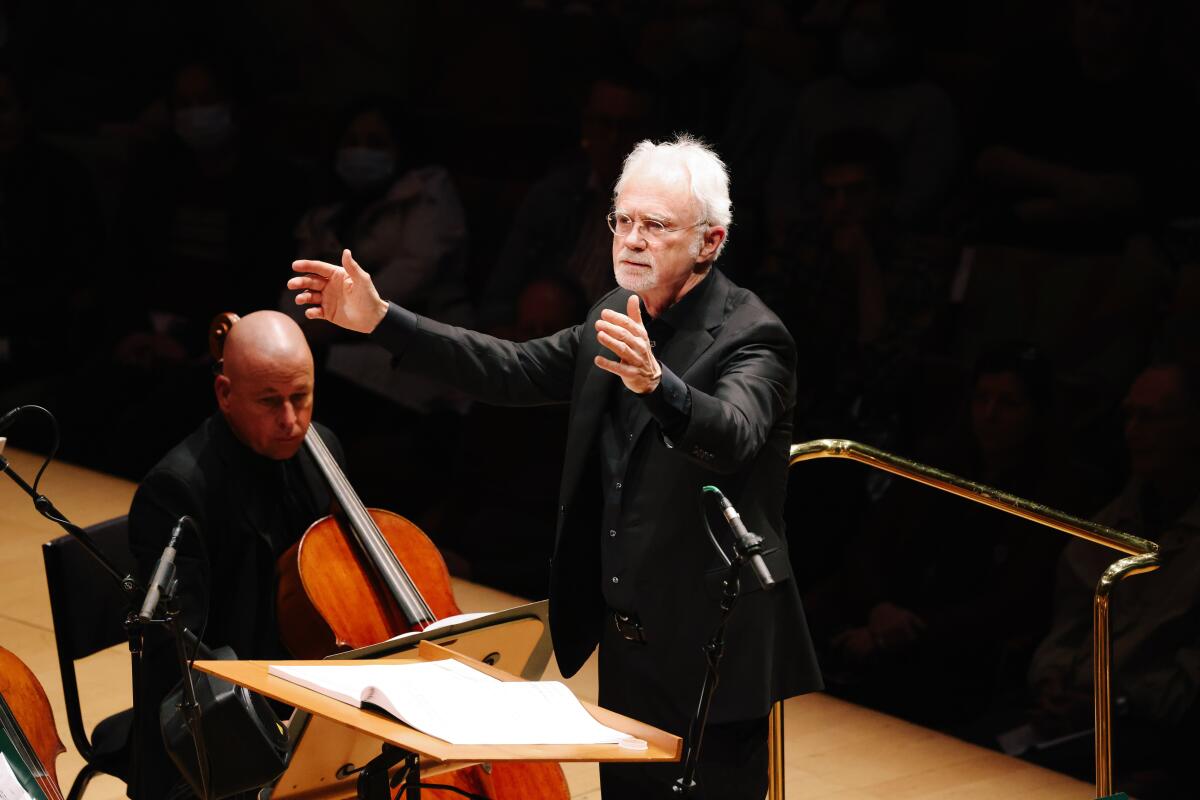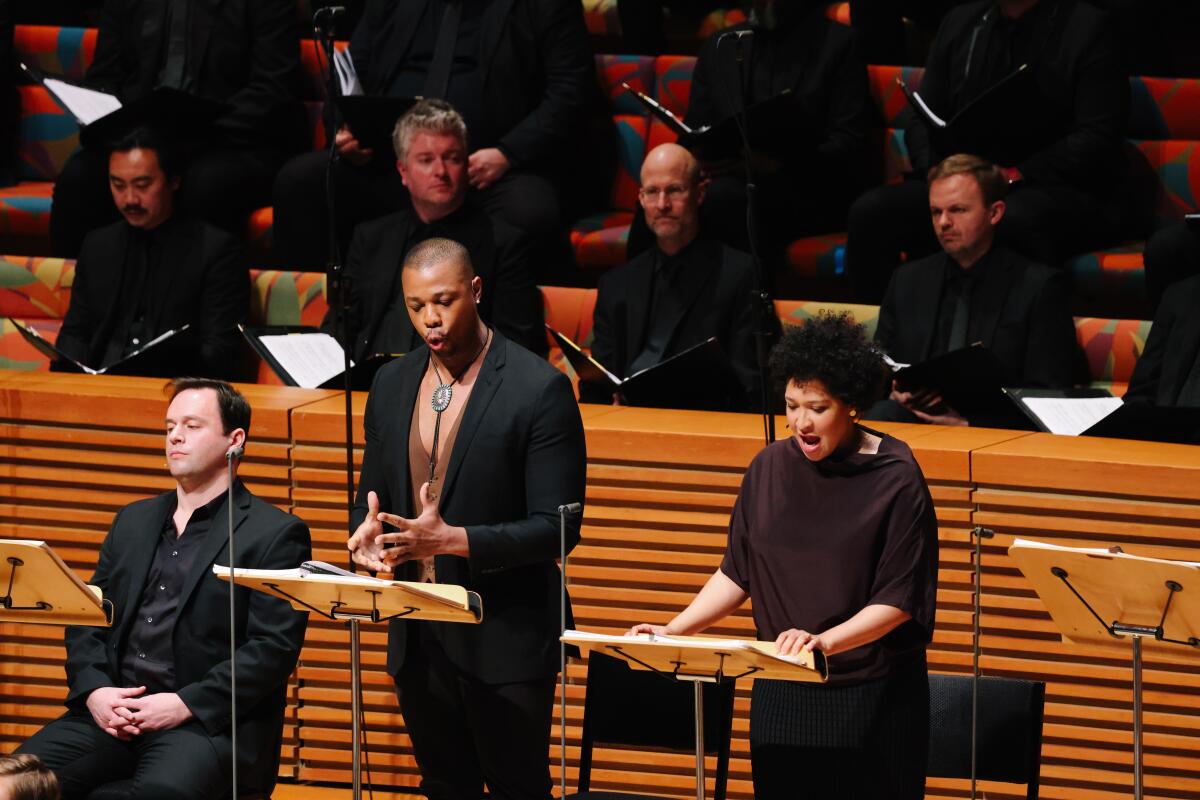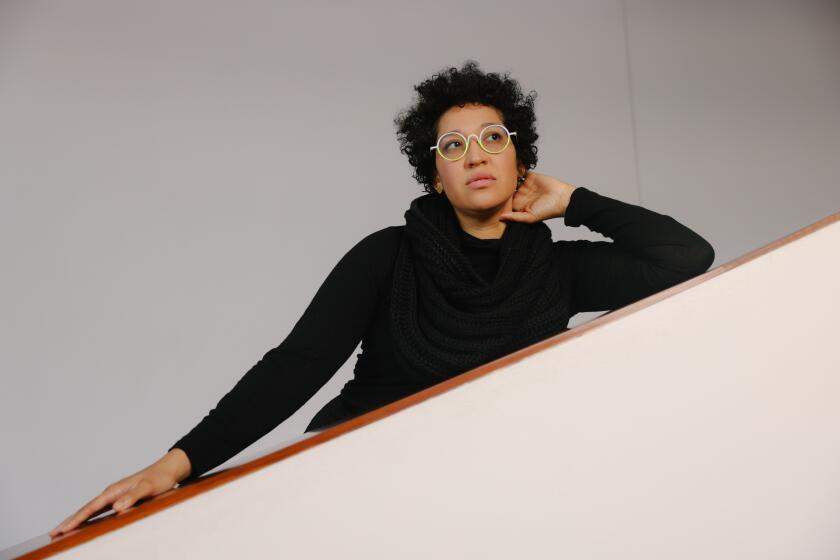There’s less Gold Rush in John Adams’ latest ‘Girls of the Golden West,’ but it’s still gold

- Share via
John Adams’ California Gold Rush opera “Girls of the Golden West,” which he conducted last weekend with the Los Angeles Philharmonic at Walt Disney Concert Hall, has been on a consequential quest of its own for operatic gold. The fourth large-scale opera by Adams and director Peter Sellars — who also provided the concept, libretto and production — was given its highly anticipated premiere by San Francisco Opera two days before Thanksgiving Day 2017. It was received as something of a mess, and a very long one at that. Even so, a few of us found it a glorious and compelling and ultimately necessary mess. The performance, we could all agree, was sensational.
Two years later, Adams and Sellars modestly revised it for its next outing by Dutch National Opera in Amsterdam. It was tighter, more theatrical, a bit more narrative-friendly and commonly operatic. The performers had seasoned and proved even more sensational. As an exposé of California’s history, the stuff we still wrangle with being taught in school, it was more boldly outlined. Its necessity as an artwork was hard to miss, though at the expense of losing some atmosphere and perspective.
Still, “Girls” has never quite recovered from its reputation as a failed opera. This is nothing new. The same could be said of the time needed to absorb big ideas, new music of substance and challenges to our ways of thinking in three previous Adams and Sellars operas: “Nixon in China,” “The Death of Klinghoffer” and “Doctor Atomic.”
“Nixon,” which languished for years after its newsy first performances 35 years ago, has finally earned its American classic status in the last decade. “Klinghoffer” is embroiled in an ongoing controversy, even as its powerfully poetic insights into Israeli and Palestinian differences become more illuminating by the minute. “Doctor Atomic” had a reception not unlike “Girls.” The opera world is coming around and, yes, with all the nuclear saber-rattling, it too matters more than ever.
In all of these operas Adams made revisions. That’s simply the business of great opera. This hugely complex art form rarely is allowed the resources to fully realize the most complicated and imaginative works the first time around. Composers, of course, need to see and hear their efforts on stage.
There weren’t very many girls to choose from for John Adams’ new opera, “Girls of the Gold West,” which had its premiere here last week.
But this time Adams has reacted dramatically to the early reactions of “Girls” and taken matters significantly into his own hands. The new version, made without Sellars, contains a little more than two hours of music, a full third less than the original. He has cut and connected expertly. The Disney concert performance, for which the singers stood at music stands behind the orchestra, not acting, went straight for the gut.
The two performances — I heard the second Sunday afternoon — were recorded by Nonesuch for release later this year. That should do the job of getting the word out that “Girls” is not a failed opera.
Many of the initial complaints were directed at Sellars, whose libretto is a cut-and-paste job of source material from the 1850s. Characters are mostly based on real people, and we hear their real words or the words of others around them. If “Girls” is talky, that’s because there is a lot that needs to be said. Here, the Gold Rush is seen through the eyes of women, of immigrants from Latin America and Asia, of Black people. Most worked in service industries.
Adams’ music is all over the map because the Gold Rush was all over the map, and he didn’t cut corners. He has said that it is his most personal opera, the composer being a Northern California transport from New England who has spent the last 40 years entranced by the Sierras. The opera excels not as documentary but as cautionary history.
A lot has changed in the five years since it first premiered, and “Girls” turns out to have been a brilliantly prescient warning of that change. At the time of the opera’s premiere, San Francisco was at the height of its own Silicon Valley Gold Rush, attracting digital miners after hedge-fund, social media and technology billions. “Girls” shows where that greed leads. Once the gold or bitcoin starts to dry up, people turn angry, looking for scapegoats and pillage.

In a way, Adams, is, himself, like his main character in “Girls,” Dame Shirley, who is based on Louise Clappe, a doctor’s wife and, like Adams, a New Englander. With elegant wit and overpowering insight, she chronicled Gold Rush goings-on. The opera revolves around her friendship (and possibly a love affair) with Ned, himself an elegant, insightful man who was formerly enslaved. Ned tries to keep his bitterness at bay, which he releases in a spectacular Fourth of July speech that speaks volumes about our own contemporary racism.
These characters are strongly drawn and could not be more persuasively inhabited than by Julia Bullock and Davóne Tines. They were emerging singers at the time of the “Girls” premiere. They’ve fully emerged.
In L.A. appearances — Julia Bullock at the Hollywood Bowl, Davone Tines at Monday Evening Concerts — they reveal opera’s future.
The full cast has mostly remained the same. That includes Paul Appleby and Ryan McKinny as the miners Joe Cannon and Clarence King, whose drunken anger transforms into terrifying mob violence. Once again, Hye Jung Lee gives a brilliant, emotionally probing coloratura performance of the sex worker Ah Sing. Elliot Madore reprises his warm personification of Ramón, a hotel worker. His lover Josefa, who is hung for trying to defend herself against rape, is newly and sympathetically sung by Daniela Mack.
The original version allowed the singers more space, more opportunities to show their different sides, particularly in the relationship between Dame Shirley and Ned. There is now less repose.
The discursive first act sets the scene, situations and perspectives shifting with uncertainty, as we sense rather than understand alliances. It originally ended in quiet, in a lovely scene between Dame Shirley and Ned, albeit one that felt as if the drama were going nowhere. That first night, some in the audience wound up going somewhere that wasn’t back to their seats, wrongly fearing another 90 minutes of nowhere.
The second act is tragedy. We witness what not only the gold wrought but even more potently what the drying up of gold brings.
The new “Girls” no longer takes the time for as much context, color or pleasure. Already in Amsterdam, Adams had added a new mob ending to the first act that brought his audience eagerly back to their seats after intermission. He had also taken out a sensational dance number during Fourth of July celebrations that intimated what trouble the pretense of patriotism can lead to.
Now much more is gone. The direction of tragedy is evident, and Adams led a performance of extreme rhythmic vitality and propulsion that made it all the more compelling. In San Francisco, Grant Gershon had offered, instead, a broader range of expansive expression. This time, Gershon served to prepare his Los Angeles Master Chorale. Adams’ thrilling choruses are among the opera’s highlights and include his inimitable own take on folk song. No chorus knows or sings Adams better than Gershon’s.
Before Julia Bullock’s appearance this weekend in the L.A. Philharmonic’s performances of John Adams’ opera “Girls of the Golden West,” the singer talks.
Some operas need cuts. Puccini improved “Madame Butterfly” by doing so. Some operas improve with expansion, as did Wagner’s “Tannhäuser.” Some exist in different versions, leaving conductors and directors the option of making their own, the case with “Boris Godunov.” Ideally, all the “Girls” material will be published and available. It would be fine with me if Adams and Sellars went back and added another hour. Why shouldn’t we have a true four-hour California grand opera by one of world’s leading opera composers, our state’s own “Götterdämmerung”?
Something else was missing Sunday — the unsightly drapery that is used to dampen Disney’s acoustics when there is amplification. Adams has pioneered amplifying singers in opera, and it remains an ongoing effort. Sunday the amplification of the singers (and lightly the orchestra) not only got it right, but also — and for the first time in this notoriously difficult to amplify hall designed for acoustic music — for the first time in the hall, without the curtains. That’s a breakthrough.
Now for the recording. In any version, “Girls of the Golden West” is important. With luck, the recording will serve to make us want more.
More to Read
The biggest entertainment stories
Get our big stories about Hollywood, film, television, music, arts, culture and more right in your inbox as soon as they publish.
You may occasionally receive promotional content from the Los Angeles Times.













